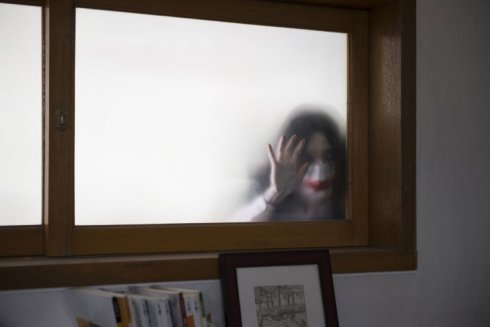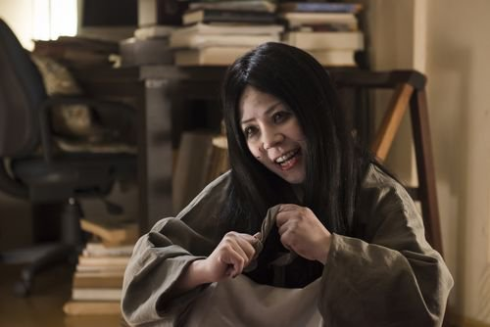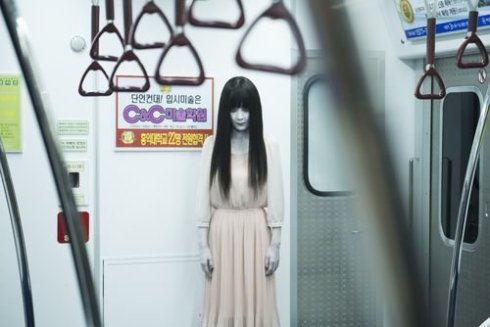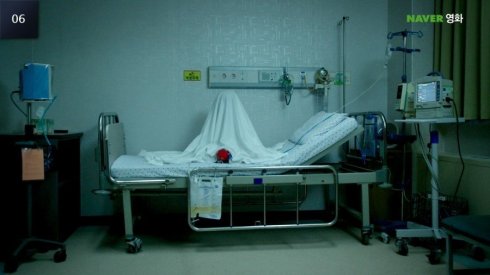A high-school boy, In-su (Kang Ha-neul) returns to his hometown in order to face up to, both literally and metaphorically, ghosts from the past. Like his Uncle, with whom he is staying, In-su has the ability to see and speak to [female] ghosts who have suffered violent and untimely deaths. Returning to his school, In-su discovers that someone is violently murdering his classmates. As he attempts to unravel the trauma in the past that has resulted in the present vengeance, In-su is accompanied by a unnamed girl ghost (hence the alternative title: Girl Ghost Story) whose presence is unexplained. Just who is responsible for the deaths, and what was the original trauma that led to such dreadful and bloody vengeance.
Mourning Grave is a welcome addition to one of my favourite Korean horror genres, High School Horror, and Director OH manages not to merely recycle the old but to breathe new life into the genre. Traditionally High School Horror of the vengeful ghost variety, is female-centric, and male characters are either non-existent or marginal to the plot. Mourning Grave breaks with this tradition, with its empathetic male protagonist In-su who seeks to right the wrongs of the past. The relationship between In-su and his constant female ghost companion (Kim So-eun) is nicely realised and the relationship has an authenticity to it which is aided by excellent performances by the two leads, Kang Ha-neul and Kim So-eun. In-su’s Uncle, Kim Jeong-tae (Seon-il), who is trying not to speak or appease ghosts, is also haunted by a female ghost, who despite his attempts to ignore her and banish her, refuses to leave.
Other critics (including Pierce Conran) have pointed out that the trend in Korean horror these days is towards hybridity. Mourning Grave demonstrates this hybridity in multiple ways. Firstly, through the character of Seon-il, who as Shaman priest (Mu) and Exorcist is the centre of a number of comedic interludes, and seems to have been imported in from classic Hong Kong Horror Cinema and secondly through multiple intertextual references (as with Seon-il) to other horror cinemas and specific films, including Carrie (Brian de Palma, US: 1976) (in particular the prom scene), and Carved: A Slit Mouthed Woman (Koji Shiraishi, Japan: 2007) – the visual iconography of the ghost is obviously a direct reference to the Japanese urban myth on which the film is based. The concept of the ghost fracturing into a number of different characters as a result of the trauma of her death was an interesting one, and added another layer of mystery to the central narrative enigma in a similar way to A Tale of Two Sisters without giving the plot away.

This is not to suggest that Mourning Grave isn’t scary or that it doesn’t have the sort of socio-political commentary around bullying that is associated with High School Horror. The bullying that lead to the death of the vengeful female ghost is horrific when it is eventually revealed, as is the reluctance of teachers and other students who are not directly involved in the bullying to intercede. Here, as elsewhere, after all according “The only thing necessary for the triumph of evil is for good men to do nothing” (a quotation often attributed to Edmund Burke, but who never said these exact words). Those who look away are situated here as equally culpable as those who actually perpetrate the violence against those weaker than them.
Mourning Grave harkens back to the early days of Korean horror cinema, when well-made genre films were all the rage, and first time directors produced films that were both narratively and technically proficient and resonated with young and older audiences alike, with prospective actresses queuing up to be considered for roles in the films. With his feature film debut, Director OH shows technical expertise, an ability to not to over-complicate the cinematographic frame, and a distinctive aesthetic style in addition to generating excellent performances from his cast. OK Clarice Eunhae’s score never overwhelms the image, instead it adds to the underlying melancholic sensibility that imbues this ghost story and coming of age story. Director OH’s feature film debut, like his short films, is engaging and extremely well-directed and I look forward to his next film with a great deal of anticipation.
Overall, this is a film for fans of Korean horror cinema, and in particular High School Horror, which hearkens back to the age of the well-made genre film while at the same time, being innovative and original. I really hope that Mourning Grave will do well at the domestic Box Office, and demonstrate to producers and directors in South Korea that horror film remains a lucrative investment – after all horror is perhaps the one genre that travels across national and international borders the easiest. I find myself wondering about a US remake, but really do not think it would work. While the film has transnational elements, seen in the intertextual and visual references to both Eastern and Western horror, it still has a specifity which marks it out as Korean without Director OH pandering to the exoticism and orientalism that underpin the West’s desire for a traditional, nostalgic and markedly Korean products that confirms stereotypes around Confucian values and irreducible alterity.
And finally, what is not to like about a film that opens with a subway ghost!












